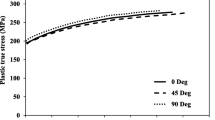Abstract
Fracture in sheet metal forming usually occurs as ductile fracture, rarely as brittle fracture, at the operating temperatures and rates of loading that are typical of real processes in two different modes: (1) tensile and (2) in-plane shear (respectively, the same as modes I and II of fracture mechanics). The circumstances under which each mode will occur are identified in terms of plastic flow and ductile damage by means of an analytical approach to characterize fracture loci under plane stress conditions that takes anisotropy into consideration. Fracture loci was characterized by means of the fracture forming limit line and by the shear fracture forming limit line in the fracture forming limit diagram. Experiments were performed with single point incremental forming and double-notched test specimens loaded in tension, torsion and in-plane shear give support to the presentation and allow determining the fracture loci of AA1050-H111 aluminium sheets with 1 mm thickness. The relation between fracture toughness and the fracture forming limits was also investigated by comparing experimental values of the strains at fracture obtained from a truncated conical part produced by single point incremental forming and from double-notched test specimens loaded in tension.








Similar content being viewed by others
References
Z. Marciniak, Adv. Technol. Plast. 1, 685 (1984)
J.B. Kim, D.Y. Yang, Eng. Comput. 20, 6 (2003)
S.P. Keeler, Circular Grid System—A Valuable Aid for Evaluating Sheet Metal Formability. SAE technical paper 680092 (1968)
G. Goodwin, Application of Strain Analysis to Sheet Metal Forming Problems in the Press Shop. SAE technical paper 68009 (1968)
H.W. Swift, J. Mech. Phys. Solids 1, 1 (1952)
R. Hill, J. Mechan, Phys. Solids 1, 19 (1952)
Z. Marciniak, K. Kuckzynski, Int. J. Mech. Sci. 9, 609 (1967)
A.G. Atkins, J. Mater. Process. Technol. 56, 609 (1996)
F.A. McClintock, J. Appl. Mech. 35, 363 (1968)
C.M. Muscat-Fenech, S. Arndt, A.G. Atkins, in Proceedings of the 4th International Conference, University of Twente, The Nederlands, 1996, pp. 249–260
T. Wierzbicki, Y. Bao, Y.W. Lee, Y. Bai, Int. J. Mech. Sci. 47, 719 (2005)
K. Isik, M.B. Silva, A.E. Tekkaya, P.A.F. Martins, J. Mater. Process. Technol. 214, 1557 (2014)
A.G. Atkins, Y.W. Mai, Elastic and Plastic Fracture: Metals, Polymers, Ceramics, Composites, Biological Materials (EllisHorwood, Chichester, 1975)
P.A.F. Martins, N. Bay, A.E. Tekkaya, A.G. Atkins, Int. J. Mech. Sci. 83, 112 (2014)
ASTM Standard E8/E8 M, Standard Test Methods for Tension Testing of Metallic Materials (ASTM International, West Conshohocken, USA, 2013)
B. Cotterell, J.K. Reddel, Int. J. Fract. 13, 267 (1977)
C. Rossard, Mise en forme des métaux et alliages (CNRS, Paris, 1976)
ISO Standard 12004-2, Metallic Materials—Sheet and Strip—Determination of Forming-limit Curves—Part 2: Determination of Forming—Limit Curves in the Laboratory, Geneva, Switzerland, 2008
V. Cristino, L. Montanari, M.B. Silva, A.G. Atkins, P.A.F. Martins, Int. J. Mech. Sci. 83, 146 (2014)
A.G. Atkins, P.A.F. Martins, Thin Sheet Fracture, in Materials Science and Materials Engineering (Elsevier, UK, 2016)
R. Hill, Proc. R. Soc. Lond. A 193, 281 (1948)
Acknowledgments
M.B. Silva and P.A.F. Martins would like to acknowledge the support provided by Fundação para a Ciência e a Tecnologia of Portugal within project LAETA-UID/EMS/50022/2013 and SFRH/BSAB/105959/2015. K. Isik and A. E. Tekkaya gratefully acknowledge funding by the German Research Foundation (DFG) within the scope of the Transregional Collaborative Research Centre on sheet-bulk metal forming (SFB/TR 73) in the subproject C4 ‘Analysis of load history dependent evolution of damage and microstructure for the numerical design of sheet-bulk metal forming processes’.
Author information
Authors and Affiliations
Corresponding author
Additional information
Available online at http://link.springer.com/journal/40195
Rights and permissions
About this article
Cite this article
Silva, M.B., Isik, K., Tekkaya, A.E. et al. Fracture Loci in Sheet Metal Forming: A Review. Acta Metall. Sin. (Engl. Lett.) 28, 1415–1425 (2015). https://doi.org/10.1007/s40195-015-0341-6
Received:
Revised:
Published:
Issue Date:
DOI: https://doi.org/10.1007/s40195-015-0341-6




